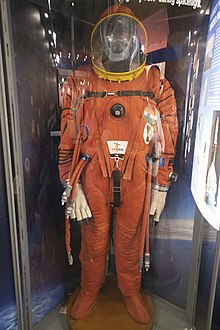
Human spaceflight is spaceflight with a crew or passengers aboard a spacecraft, often with the spacecraft being operated directly by the onboard human crew. Spacecraft can also be remotely operated from ground stations on Earth, or autonomously, without any direct human involvement. People trained for spaceflight are called astronauts, cosmonauts (Russian), or taikonauts (Chinese); and non-professionals are referred to as spaceflight participants or spacefarers.
Human spaceflight programs have been conducted, started, or planned by multiple countries and companies. Until the 21st century, human spaceflight programs were sponsored exclusively by governments, through either the military or civilian space agencies. With the launch of the privately funded SpaceShipOne in 2004, a new category of human spaceflight programs – commercial human spaceflight – arrived. By the end of 2022, three countries and one private company (SpaceX) had successfully launched humans to Earth orbit, and two private companies had launched humans on a suborbital trajectory.

The Indian Space Research Organisation is the national space agency of India. It operates as the primary research and development arm of the Department of Space (DoS), which is directly overseen by the Prime Minister of India while the Chairman of ISRO also acts as the executive of DoS. ISRO is primarily responsible for performing tasks related to space-based operations, space exploration, international space cooperation and the development of related technologies. ISRO is one of the six government space agencies in the world that possesses full launch capabilities, can deploy cryogenic engines, can launch extraterrestrial missions and operate a large fleet of artificial satellites. ISRO is one of the four government space agencies to have soft landing (unmanned) capabilities.

Satish Dhawan Space Centre – SDSC, is the primary spaceport of the Indian Space Research Organisation (ISRO), located in Sriharikota, Andhra Pradesh.

The Launch Vehicle Mark-3 or LVM3 is a three-stage medium-lift launch vehicle developed by the Indian Space Research Organisation (ISRO). Primarily designed to launch communication satellites into geostationary orbit, it is also due to launch crewed missions under the Indian Human Spaceflight Programme. LVM3 has a higher payload capacity than its predecessor, GSLV.

The Indian Human Spaceflight Programme is an ongoing programme by the Indian Space Research Organisation (ISRO) to develop the technology needed to launch crewed orbital spacecraft into low Earth orbit. Three uncrewed flights, named Gaganyaan-1, Gaganyaan-2 and Gaganyaan-3 are scheduled to launch in 2024, followed by crewed flight in 2024 on an HLVM3 rocket.
Human-rating certification, also known as man-rating or crew-rating, is the certification of a spacecraft or launch vehicle as capable of safely transporting humans. There is no one particular standard for human-rating a spacecraft or launch vehicle, and the various entities that launch or plan to launch such spacecraft specify requirements for their particular systems to be human-rated.

Gaganyaan is an Indian crewed orbital spacecraft intended to be the formative spacecraft of the Indian Human Spaceflight Programme. The spacecraft is being designed to carry three people, and a planned upgraded version will be equipped with rendezvous and docking capabilities. In its maiden crewed mission, the Indian Space Research Organisation (ISRO)'s largely autonomous 5.3-metric ton capsule will orbit the Earth at 400 km altitude for up to seven days with a two- or three-person crew on board. The first crewed mission was originally planned to be launched on ISRO's HLVM3 rocket in December 2021. As of October 2023, it is expected to be launched by 2025.

The ISRO Pad Abort Test was an Indian Space Research Organisation launch escape system test of its crew module as part of Indian Human Spaceflight Programme. The successful test took place on 5 July 2018.
Dr.V. R. Lalithambika is an Indian engineer and scientist who has been working with the Indian Space Research Organisation (ISRO). She is a specialist in Advanced Launcher Technologies and was leading the Gaganyaan mission to send Indian astronauts to space by 2022.

Vyommitra is a female-looking spacefaring humanoid robot developed by the Indian Space Research Organisation to function on-board the Gaganyaan, a crewed orbital spacecraft. Vyommitra was first unveiled on 22 January 2020 at the Human Spaceflight and Exploration symposium in Bengaluru.

Test Vehicle Abort Mission-1 (TV-D1) was a high altitude abort test performed as part of the Gaganyaan program, initially set to be held on 21 October 2023 at around 02:30 UTC. Liftoff was delayed to 03:15 UTC due to weather issues, and five seconds before launch it was put on hold by the on-board computer due to an engine anomaly, as reported in ISRO's mission livestream. The launch occurred at 04:30 UTC, and the crew module successfully separated from the launch vehicle. The crew module was successfully recovered by the Indian Navy. India is the fourth country, after Russia, the United States, and China, to successfully test this technology.
Gaganyaan-1 will be the first uncrewed test flight of the Gaganyaan programme, with launch planned for July 2024.

The Bharatiya Antariksha Station, is a planned modular space station to be constructed by India and operated by the Indian Space Research Organisation (ISRO). The space station would weigh 20 tonnes and maintain an orbit of approximately 400 kilometres above the Earth, where astronauts could stay for 15–20 days. Originally planned to be completed by 2030, it was later postponed to 2035 due to delays caused by technical issues related with the Gaganyaan crewed spaceflight mission and the COVID-19 pandemic in India. As of December 2023, the first module is expected to be launched in 2028 on an LVM3 launch vehicle, with the remaining modules to be launched by 2035 on the Next Generation Launch Vehicle.

Gaganyaan-4 will be the first crewed test flight of the Gaganyaan programme, with launch planned for 2025.
Gaganyaan-3 will be the third uncrewed test flight of the Gaganyaan programme, with launch planned in 2025.












